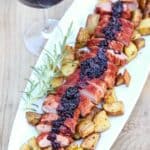Smoked Pork Tenderloin Recipe with Smoked Blackberry Bourbon Sauce
An easy smoked pork tenderloin recipe topped with a rich smoked blackberry bourbon sauce. An amazing combination of pork, sweet, and savory flavors.
Servings: 4 people
Cost: $15
Ingredients
For the Pork Tenderloin
- 2 pounds pork tenderloin (2 pork tenderloins), silver skin trimmed off
- 1 tablespoon Dijon mustard, (for coating)
- 2 tablespoons pork rub
For the Blackberry Bourbon Sauce
- 1 pint fresh blackberries
- 1 tablespoon sugar
- 1 teaspoon salt
- ¼ cup bourbon
- 1 teaspoon extra virgin olive oil
- 2 tablespoons diced shallots
- ¼ cup balsamic vinegar
- 2 teaspoons fresh chopped rosemary
- ½ teaspoon sugar optional
Instructions
Blackberry Bourbon Sauce
- Set smoker between 225-250 degrees using fruit wood.
- Rinse the berries and place them in a glass baking dish (8x8 works well for this). Toss with 1 tablespoon sugar, 1 teaspoon salt, and ¼ cup bourbon.1 pint fresh blackberries, 1 tablespoon sugar, 1 teaspoon salt, ¼ cup bourbon
- Place on smoker and cook for 90 minutes then remove. The berries will have a slight smoked nose to them and have slightly reduced.
- In a small saucepan add the extra virgin olive oil and shallots over medium heat. Let them soften (about 3-5 minutes). Add balsamic and bring to a boil (about 1 minute). Add the smoked berries with bourbon juices. Add the rosemary. Let them cook together about 5 minutes, stirring often.1 teaspoon extra virgin olive oil, 2 tablespoons diced shallots, ¼ cup balsamic vinegar, 2 teaspoons fresh chopped rosemary
- Using a fork or potato masher, press down on the berries to break them up into a chunky sauce. Taste and adjust flavors. If not sweet enough add an additional ½ teaspoon of sugar at a time.½ teaspoon sugar
- Remove and drizzle the blackberry sauce over the smoked pork tenderloin.
How to Smoke Pork Tenderloin
- Set smoker between 225-250 degrees using fruitwood like apple or cherry.
- Coat the pork tenderloin with a layer of Dijon mustard (just to coat and allow the dry rub to adhere), then sprinkle the pork tenderloin with the pork rub.2 pounds pork tenderloin (2 pork tenderloins), silver skin trimmed off, 1 tablespoon Dijon mustard,, 2 tablespoons pork rub
- Place on smoker, and cook up to 90 minutes or until the internal temperature in the thickest part of the tenderloin is 140 degrees Fahrenheit.
- Remove and let rest 10 minutes. Slice and drizzle the blackberry bourbon sauce over the top.
Notes
Preparation: The blackberry sauce can be made the day before and then warmed up right before serving the pork tenderloin. Or you can smoke the berries first for 30 minutes, then add the pork tenderloin and make sauce as the pork tenderloin rests.
The Seasoning: We use our pork rub, but you can use any sweet rub that you have on hand. Otherwise you can also look at all our seasonings and find the one that matches the flavor profile you like.
About Cooking Times: Pork tenderloin can cook in as little as 45 minutes or as much as 90 minutes. The most important thing to monitor is the internal temperature and pulling when the internal temperature is no higher than 140. As the tenderloin rests, the internal temperature will increase by up to 5 degrees which is called carry over cooking.
Nutrition
Calories: 695kcal | Carbohydrates: 23g | Protein: 96g | Fat: 18g | Saturated Fat: 6g | Polyunsaturated Fat: 3g | Monounsaturated Fat: 7g | Trans Fat: 1g | Cholesterol: 295mg | Sodium: 867mg | Potassium: 2065mg | Fiber: 7g | Sugar: 12g | Vitamin A: 461IU | Vitamin C: 26mg | Calcium: 144mg | Iron: 8mg
